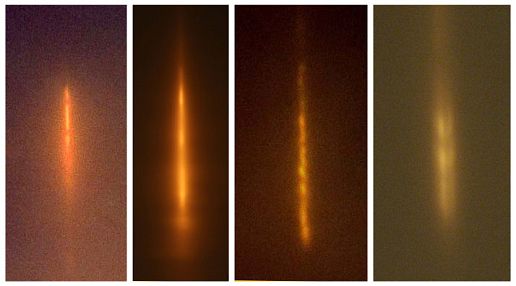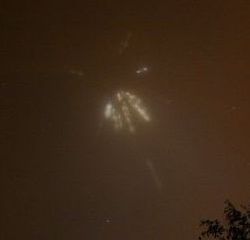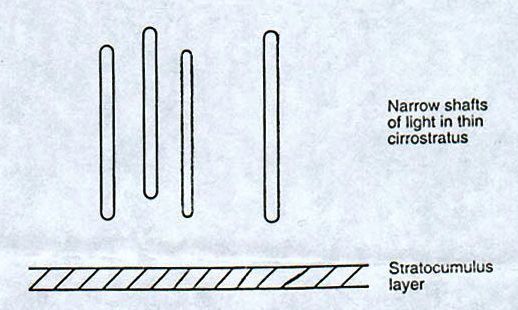|
R e s e a r c h
Aspect
Usually, reflections from ground-based lights in high clouds appear as vertically oriented pillars of light. An 1887 article from the American Meteorological Journal describes the phenomenon, then referred to as "gas comets", as "bright streaks or bars of light (...), measuring on an average one-quarter of a degree in width and from 5 to 15 degrees in length" [9].

Four examples of light pillars showing peculiarities. From left to right: segmented pillar caused by a gas flame reflecting off separated ice-crystal layers positioned one on top of the other; pillar with multiple nuclei caused by the reflection of a gas flame in a thick cloud with different concentrations of ice crystals at different altitudes; rope pillar, also caused by a gas flame, but here the reason for its specific shape is unclear; combined pillar presumably caused by multiple spotlights placed close together.
Next to the common pillar shape, observers standing close to a bright light source have reported tear-drop and circular reflections close to the zenith. An example of such a display occurred on October 20, 1993, when pillar-shaped reflections were observed in combination with teardrop and circle-shaped lights from two ships and two gas production platforms in the North Sea. 
Reflections observed on October 20, 1993, from different locations in the southern part of the North Sea.
Because of the nature of the reflecting stratum (not a flat mirror but a cloud made up of billions of tiny mirrors), light pillars sometimes appear as 3-dimensional shapes, leading observers to describe them as solid objects. Descriptions such as "a disc standing on edge", "a luminous cigar", "a bright cylinder" and "a rocket-shaped object" are regularly encountered in reports collected from the UFO literature.
A vertical shaft of light extending from 19° alt. Upwards, "white at the top" and "yellow-red at the bottom", described as "a trifle thicker at the bottom than at the top", was seen at Oklahoma City on the morning of 1938, Feb. 28 (midnight to 6 a.m.), but was definitely identified by Carl Winstead, weather bureau flier, as originating from a burning oil flame in the south city oil field, reflected in a light cloud which appeared as a slight fog when the pilot went out of it at 13,000 ft. [3,962 km]. Winstead flew around and thru the light and said that from above it appeared like a flat spotlight which ended suddenly. In spite of this sensible interpretation, the newspaper report harped on the "mystery" of the light, headlined it as a "Comet or Something" and entertained notions of the "the tail of a meteor"!
Sightings from locations close to the source of the reflection are rare. In most instances distances between 20 and 50 km (12 and 31 miles) were recorded. The maximum distance reported to date (July 2007) is 139 km. The sighting in question took place on August 24, 1998. While navigating through the East China Sea, Captain J.L. PETERSON and members of his crew spotted "four shafts of narrow vertical light reflected in the sky". They discovered that the reflections were caused by four flares of the Kakap Natuna oil terminal "75 n mile away" [10].
The reason why light pillars in high clouds are rarely observed from short distances is believed to be that objects and lights in the sky are more readily spotted when they are close to the horizon, i.e. when the source of the reflection is located at a great distance from the observer.
Colour
In cases where flames or fires are involved, the pillars usually appear as yellow or orange-red, at times with pink or blue edges or halos. In the case of a searchlight or spotlight, the pillars will look white or bluish-grey. When coloured filters are placed in front of the lamps the reflection will assume the colour of the filter. In essence, the colour of the reflection is determined by the colour of the light source.
Brightness
The brightness depends not only on the nature of the light source and the distance between the observer and the reflection, but also on the type of ice-crystals, their size, the smoothness of their surfaces and the way in which they are scattered within the cloud. A flat horizontal layer consisting of large ice-crystal plates with smooth surfaces will generate a crisp and colourful image, whereas a cloud of randomly scattered oscillating ice-particles of small size will produce an image with diffuse edges and a less outspoken colouring.
Sounds
Especially in cases where petrochemical works are involved, the reflections are sometimes accompanied by a variety of sounds. During one of his personal observations, the author, standing 8.6 km (5.3 miles) from a blazing gas flame, noticed a sound resembling the pulsating roar of a flame thrower. In other cases, observers described sounds that they compared to a vacuum cleaner, a refrigerator and a helicopter in slow motion. In some instances the sound of gases escaping under pressure was perceived. High-pitched humming sounds have been mentioned as well.
Notes & References
[9]
HOOK, Joseph A. and ROBERTS, T.P., "Aerial Reflections over Burning Gas Wells" in American Meteorological Journal, Vol. IV, February 1887, page unknown. Thanks to Barry GREENWOOD for mailing us a photocopy of this article.
|
|||||||

